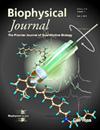Exploring the structural and dynamical features of bacterial-tubulin FtsZ
IF 3.2
3区 生物学
Q2 BIOPHYSICS
引用次数: 0
Abstract
FtsZ, a bacterial tubulin, plays a crucial role in the cytokinesis process. It shares structural similarities with tubulin, as it consists of two domains—N-terminal and C-terminal domains. The protein assembles to form single-stranded protofilaments that exhibit a dynamic phenomenon known as treadmilling where the FtsZ filaments appear to execute a unidirectional movement even though individual monomers constituting the filament do not move. Despite forming protofilaments, an FtsZ molecule requires a conformational switch to form stable contacts with neighboring subunits in a filament. Therefore, FtsZ has two well-characterized conformations based on its polymerization propensity: 1) R state, preferred by the monomeric FtsZ and 2) T state, preferred by the polymeric FtsZ. The treadmilling ability of FtsZ is coupled with the conformational switch and the GTPase activity of the protein as hydrolysis-deficient mutants of FtsZ do not treadmill. We employ all-atom molecular dynamics simulations to investigate certain structural and dynamical features of the protofilaments by considering FtsZ heptamers as our model system. We simulated FtsZ filaments in three nucleotide states—GTP, GDP, and GDP-Pi—to understand the conformational states of the terminal monomers, interface dynamics of the filaments, and important interactions at the protein interdomain and interface regions. Our study reveals that the γ-phosphate binding loop T3 prompts the structural rearrangements at the interface post hydrolysis.细菌微管蛋白FtsZ的结构和动力学特性探讨
FtsZ是一种细菌微管蛋白,在细胞分裂过程中起着至关重要的作用。它与微管蛋白具有结构上的相似性,因为它由两个结构域- n端和c端组成。蛋白质组装形成单链原细丝,表现出一种称为“跑步”的动态现象,其中FtsZ细丝似乎在执行单向运动,即使构成细丝的单个单体不移动。尽管形成了原丝,但FtsZ分子需要一个构象开关来与丝中的邻近亚基形成稳定的接触。因此,根据其聚合倾向,FtsZ具有两种表征良好的构象:1)R态,由单体FtsZ优选;2)T态,由聚合物FtsZ优选。FtsZ的“跑步”能力与蛋白质的构象开关和GTPase活性有关,因为FtsZ的水解缺陷突变体不“跑步”。我们以FtsZ七聚体为模型体系,采用全原子分子动力学模拟来研究原丝的某些结构和动力学特征。我们模拟了三种核苷酸状态(gtp、GDP和GDP- pi)的FtsZ细丝,以了解末端单体的构象状态、细丝的界面动力学以及蛋白质结构域间和界面区域的重要相互作用。我们的研究表明,γ-磷酸盐结合环T3促进了界面水解后的结构重排。
本文章由计算机程序翻译,如有差异,请以英文原文为准。
求助全文
约1分钟内获得全文
求助全文
来源期刊

Biophysical journal
生物-生物物理
CiteScore
6.10
自引率
5.90%
发文量
3090
审稿时长
2 months
期刊介绍:
BJ publishes original articles, letters, and perspectives on important problems in modern biophysics. The papers should be written so as to be of interest to a broad community of biophysicists. BJ welcomes experimental studies that employ quantitative physical approaches for the study of biological systems, including or spanning scales from molecule to whole organism. Experimental studies of a purely descriptive or phenomenological nature, with no theoretical or mechanistic underpinning, are not appropriate for publication in BJ. Theoretical studies should offer new insights into the understanding ofexperimental results or suggest new experimentally testable hypotheses. Articles reporting significant methodological or technological advances, which have potential to open new areas of biophysical investigation, are also suitable for publication in BJ. Papers describing improvements in accuracy or speed of existing methods or extra detail within methods described previously are not suitable for BJ.
 求助内容:
求助内容: 应助结果提醒方式:
应助结果提醒方式:


